Spanish Colonization
1/16
There's no tags or description
Looks like no tags are added yet.
Name | Mastery | Learn | Test | Matching | Spaced |
|---|
No study sessions yet.
17 Terms
Philippines under imperial Spain
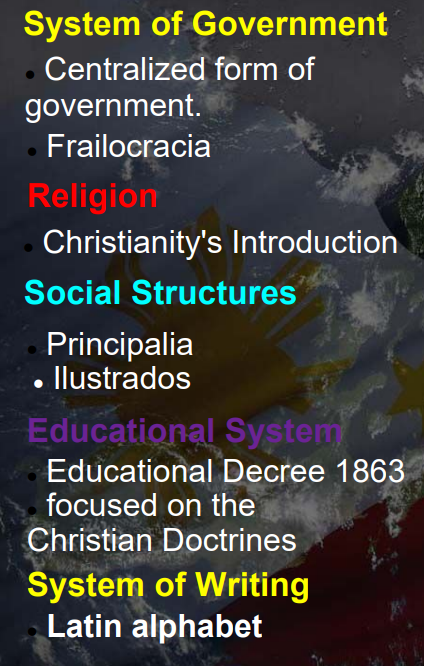
Encomienda
Land owner ship system
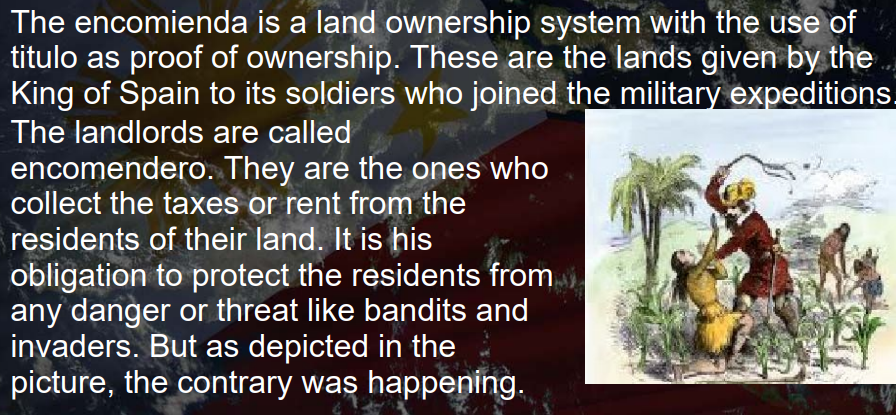
Forced Labor (Polo y servicio)
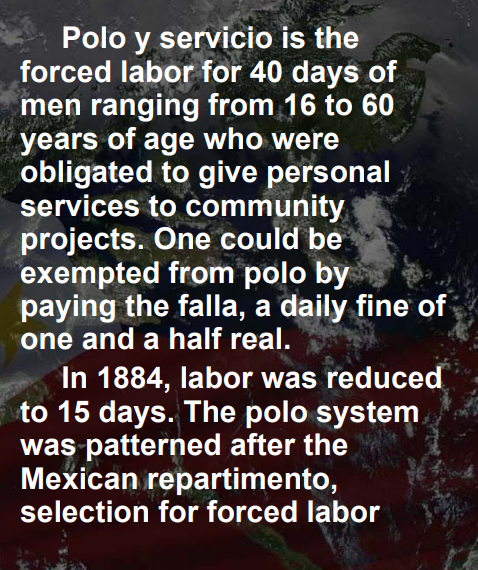
Taxation
To support the colony, several forms of taxes and monopolies were imposed.
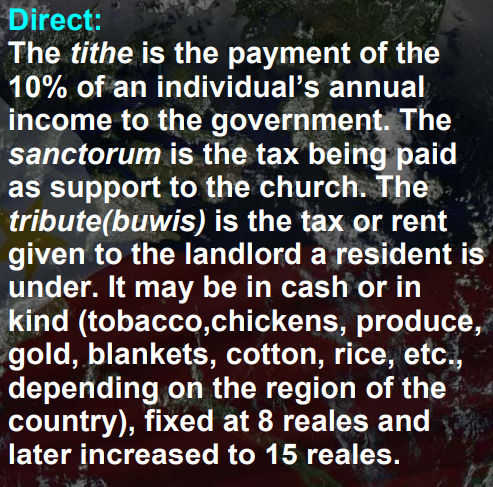
Manila-Acapulco Galleon Trade
What it was:
A trade route between Manila (Philippines) and Acapulco (Mexico).
Lasted over 250 years, starting in 1565 and ending in 1821.
Main goods exchanged:
From New Spain (Mexico): Silver
From China (via Manila): Silk
The Philippines acted as a middleman, earning money by reselling these goods.
Impact:
Major source of income for the colony.
But it caused problems:
Local industries and farming were neglected.
Native Filipinos were burdened by forced labor and taxes.
End of the trade:
It stopped in 1821 when Mexico broke away from Spain.
Royal Philippine Company (1785–1814)
Founded by:
King Charles III of Spain on March 10, 1785
Given a 25-year charter
Purpose:
Exclusive monopoly to bring Chinese and Indian goods to Manila
Ship them directly to Spain via the Cape of Good Hope
Opposition:
Dutch and English traders — saw it as a threat to their Asian trade
Galleon trade merchants — feared competition
Outcome:
Both systems collapsed:
Royal Company ended in 1814
Galleon trade ended in 1815
Philippine Economy During Spanish Rule
Overall condition:
The economy was underdeveloped and a financial burden to Spain.
Spain faced annual deficits from managing the colony.
Efforts to improve agriculture:
The Economic Society of Friends of the Country helped boost farming.
The Tobacco Monopoly made the Philippines a major tobacco producer in Asia.
Farmers had quotas.
Surplus tobacco was sold to the government.
Problems with Spanish policies:
Policies mostly benefited Spaniards, not Filipinos.
Government officials were mostly Spanish, while Filipinos did the hard labor.
Filipinos were often forced to work for free and beyond their hours.
Impact on Filipino workers:
Those in the Galleon Trade suffered from heavy workloads.
Many died or were separated from families due to poverty and harsh conditions.
Colonial Government of Spain
Colonial Government Under the King of Spain
Top Authority:
King of Spain — ultimate ruler
🏛 Two Main Branches:
1. Executive Branch
Led by: Governor-General Levels of Local Government:
Province: Alcalde Mayor (Provincial Governor)
Town (Pueblo): Gobernadorcillo
Barrio (Village): Cabeza de Barangay
2. Judicial Branch
Includes: Royal Audiencia, Residencia, Lower Courts, Governor-General Levels of Local Judiciary:
Province: Corregidor (Judicial Officer)
City: Ayuntamiento (City Council)
Cabildo — made up of:
Alcalde (Mayor)
Regidores (Council Members)
Escribano (Clerk)
Barrio: Cabeza de Barangay (same as in Executive)
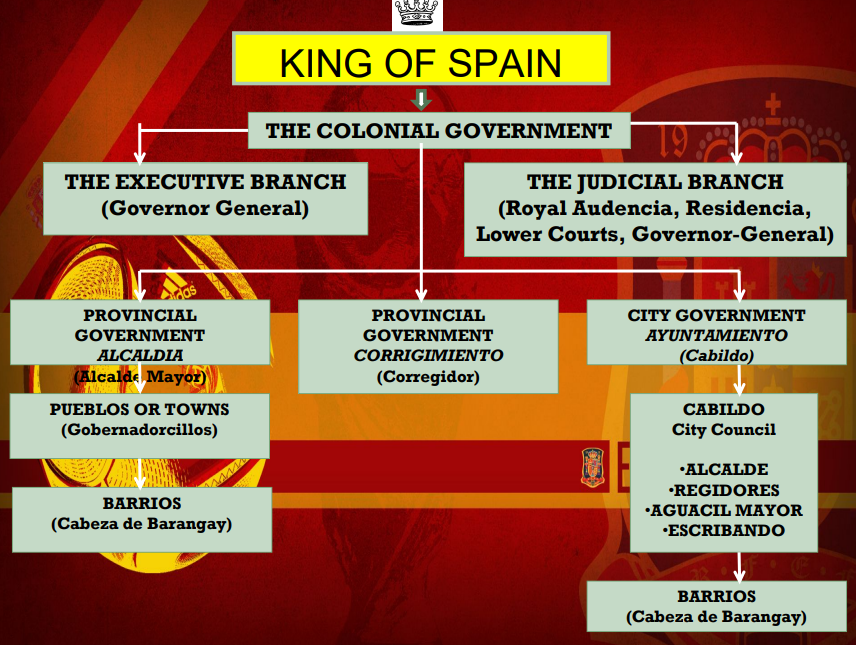
The Political Structure
Type of Government:
Centralized Colonial Government
Split into National Government and Local Governments
National Government Responsibilities:
🕊Maintained peace and order
💰 Collected taxes
🏫 Built schools and public infrastructure
Reach of Authority:
Controlled provinces, cities, towns, and municipalities
The Governor General of the Philippines
Who they were:
The King of Spain’s top representative in the Philippines
Held the highest authority in the colony
⚔ Powers and Responsibilities:
Appointed and dismissed public officials
Commanded the army
Served as President of the Royal Audiencia
Acted as Chief Justice of the Supreme Court
🧍♂ Notable Governor-Generals:
Miguel Lopez de Legazpi (1565–1572) — first
Diego de los Rios (1898) — last
There were 115 Spanish Governor-Generals in total.
🕵 Oversight Bodies (to check abuses of power):
Residencia — investigated officials after their term
Visita — surprise inspections
Royal Audiencia — colonial high court
The Residencia
What it was:
A special judicial court used to investigate the outgoing Governor General’s performance
Who was involved:
The incoming Governor General usually took part in the investigation
A report was sent to the King of Spain with the findings
Purpose:
To check for abuse of power and ensure accountability before the transition of leadership
The Visita
What it was:
A special inspection sent by the Council of the Indies in Spain
Who led it:
A government official called the Visitador General
Purpose:
To observe conditions in the colony
To report findings directly to the King
The Royal Audencia
What it was:
The highest court in the Philippines during Spanish rule
Also served as an advisory body to the Governor General
🛡 Key Functions:
Checked and reported abuses of power by the Governor General
Audited government spending
Sent yearly reports to Spain
Allowed other officials, including the Archbishop, to report abuses too
The Provincial Government
Two Types of Local Government Units (LGUs):
Type | Leader | Area Governed | Notes |
|---|---|---|---|
Alcaldía | Alcalde Mayor | Provinces fully under Spanish control | Had duties like law enforcement, tax collection, and representing the King |
Corregimiento | Corregidor | Provinces not yet fully pacified | Often more militarized and unstable |
💰 Perks for Officials:
Though paid little, both Alcalde Mayor and Corregidor enjoyed the Indulto de Comercio → This gave them the right to join the Galleon Trade, a lucrative privilege
The City Government
What it was:
The Ayuntamiento was the governing body in cities (larger towns that became trade and industry centers)
It included the Cabildo, or city council
Members of the Cabildo:
Role | Function |
|---|---|
Alcalde (Mayor) | Head of the city government |
Regidores | Councilors who helped make decisions |
Alguacil Mayor | Chief of police |
Escribano | Secretary or clerk |
The Municipal Government
Leader:
Gobernadorcillo (“Little Governor”) — head of the town
Main Duties:
Ensured efficient governance
Collected taxes
Four Lieutenants Who Assisted the Gobernadorcillo:
Role | Responsibility |
|---|---|
Teniente Mayor | Chief lieutenant, second-in-command |
Teniente de Policía | Oversaw peace and order |
Teniente de Sementeras | Managed agricultural fields |
Teniente de Ganados | Supervised livestock |
Cabeza De Barangay (Barrio Administrator or Barangay Captain)
Responsibilities:
Maintained peace and order in the barrio
Recruited men for public works (forced labor)
📜 Qualifications:
Must be literate in Spanish
Have good moral character and own property
Cabezas who served for 25 years were exempted from forced labor